Author-Anju.Ghyanchand.
Any place you visit in India has its own unique idiosyncrasies thatare inimitable and make it different from other parts of the country, food usually being one of themost prominent factors in defining that identity. Coorg is certainly no less, and when it comes to food, Coorgi’s have a very meaty palate.Those visiting this wonderland with a taste for spicy non vegetarian fare will most likely leave their hearts here!
Coorg is synonymous with coffee but also with pork…yep…you would’ve definitely heard that “Coorgi’s stuff themselves with pork and drink like fish”. It has earned this reputation with abject justice. They really are big on food and drinking.
PANDI CURRY AND KADAMBUTTU
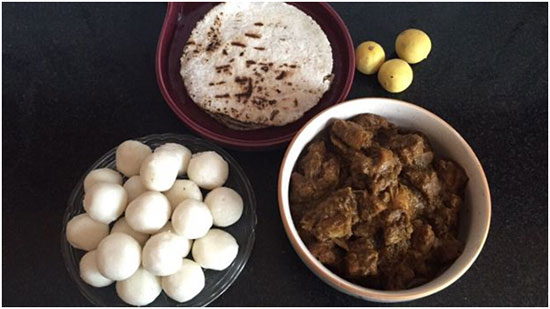
Most famous is perhaps, the pandicurry, a luxurious pork curry that is paired usually with kadambuttu or steamed rice balls. Chances are you have heard the name before my having mentioned it. This dish originated from the times of the raj, when hunting wild boar and consuming its meat was commonplace. Now that hunting isillegal,domesticated pigs have replaced wild boar. This dish is their own invention and can go from extremely spicy to mediumspicy to less spicy, but spicy is the operating word. Beingenriched with cardamom, coconut and other spices and condiments, this pork curry is as luscious as it is tantalising.The other ingredient distinct in this dish is the kachumpuli or fermented juice of the panapuli, a locally grownfruit. The English name is brindle berry.It is dark and resembles balsamic vinegar and is similar to kokum found in Goa. This gives the meat its desired pungency and also supposedly cuts down on the cholesterol in the dish.Medical tests have also revealed that this fermented vinegar counteracts the ill effects that alcohols have on the liver. It is indispensable to kodava kitchens and you will taste it in more than one dish on your stay here.
None of the meats cooked here use any external source of oil. They are cooked in their own fat which means that they are rich in their flavour and extremely potent! Lentils are rarely eaten and wheat is a recent addition to their diets.
The famous pandi curry (pork) is one dish that you might want to recreate at home. Make sure to pick up the two key ingredients that are necessary for this dish -the pork masala powder and the kachampuli syrup. You can also try to make the pork masala yourself. But for the uninitiated,packets of pre-prepared pork masala powder and the kachumpali syrup are readily available in the local grocery stores in the towns of Coorg. The powder is basically a mix of locally grown spices slowly roasted to a deep brown colour and then finely powdered.Chances are that it will taste different from the spices available outside Coorg so be sure to pick one if you believe in complete authenticity. The Kachampuli syrup should also be picked up from here as this is the flavour that makes the curry sour.
COMBINATION FOODS
Combination foods are standard here in Coorg; string hoppers known as noolputtu eaten with chicken “kozhi” curry, steamed rice “paputtu” with mutton “yerachi” curry and mutton pulao with “kaipulipajji” a bitter orange chutney or raita.
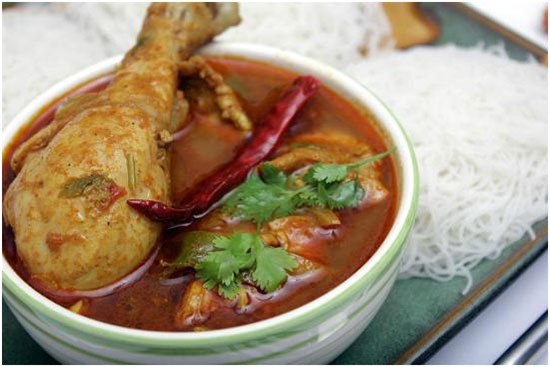
VEGETARIAN OFFERINGS
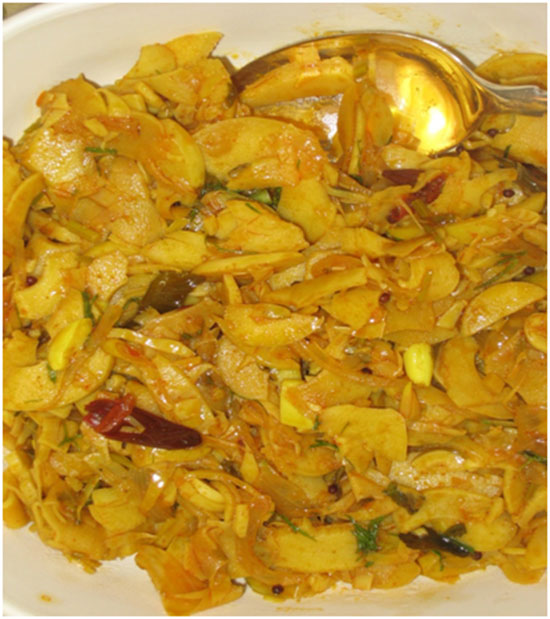
Yep, meat, meat and more meat! Though there are vegetarian offerings too, like” baimballe” bamboo shoot and “kumbala”pumpkin which are integrated into the food. Fried “balekai “raw banana chips and curries made from the same are popular. So is “kuru” black eyed beans curry. “Pottu”, steamed veg curries are tasty as is the chutney made in Coorg….everything from “mudrakani” Bengal gram chutney and “mangye” mango chutney, yellpajji sesame seed chutney is available here. They are very different from the chutneys and pickles found up north and are consumed with almost every meal, there being so many varieties of it. A lot of coconut is used in the chutneys along with garlic and onions. This packs the chutneys full of flavour and acts as a garnishing as well, the authentic way of cooking Kodava food. The speciality of this cuisine is that it relies heavily on seasonal fruits and veggies and other plant parts like ferns and stems to bring in more flavour and variety.
The use of green chillies is more prevalent than the use of red chillies. The green ones are known cut down fat in the body and are believed to be the healthier choice.
BOLLARI FRY
Bollari fry made from Mangalore cucumber with its slight sweetish touch is a great accompaniment to akki roti, which is made out of rice flour. This dish quickly becomes a favourite of all who taste it. Being a simple dish to cook, it is as filling as it is tasty. It is not surprising to see that almost all the Kodava dishes have paddy, it being a staple crop grown in this region. Rice is also eaten with kanji a vegetable stew.
ODUPUTTU
The ethereal oduputtu or “odu”, another speciality is made from unfermented rice batter sometimes with a little fenugreek seed ground into the rice .What really makes it unique is how it is made. Nooil whatsoever is used; instead, the pan is rubbed with a lump of resin, known as “banda”. This is the hardened resin of the Indian Copal tree, Vateriaindica. As the resin vaporizes, it leaves a barely discernible trace on the base, which takes on a subtle, elusive, fragrance that fills the entire room. You can almost eat the scent before even putting a morsel in your mouth.
BELLA KAPI
Plenty of coffee added is in the mix too. Bella kapi- black coffee with jaggery needs to be tasted to get the full effect of how incredible raw coffee flavour can be. Make sure you do try it next time you’re here. You will not come out of the experience disappointed, I can guarantee you that. And if you are still unsatisfied, wait till you smell the homemade wines…there are so many varieties that you would have to be in human to not appreciate at least one flavour!Cashews,hibiscus, pineapples ,rose petals, plums, raisins, rice, persimmons, passion fruit, , grapes, gooseberries,… well pretty much anything that catches their fancy is fermented and turned to liquid immediately! The downside is that homemade wines need to be consumed within a year or two of being brewed. The longer they are unconsumed, the faster they degenerate into sediments, or worse… turn into vinegar that will need to be discarded.
If you are still unconvinced (and most likely, the fussiest eater in the world!),you can stick to the traditional south Indian breakfast comprising ofiddi appams, dosas, upma, idlis, and appams which can be eaten with the usual accompaniments of coconut chutney, sambhar and vegetable stew.
KUMMU CURRY
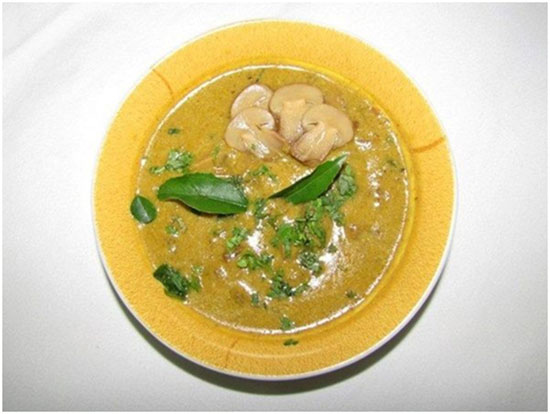
If you love mushrooms, you should try out the Kummu curry which has all the classic Coorgi flavours and spices which really make the mushroom shine and turns an ordinary ingredient into something quite delightful! Chuttakummu is roasted mushrooms which are simply delicious! Mushrooms are also pickled.
SESAONAL FRUITS AND VEGETABLE DELIGHTS
Seasonal vegetables and fruits are also consumed asthey are fresh and packed with flavour like the jackfruit and bamboo that grows in the rainy season. Koovaleputtu is made from jackfruit steamed in the banana leaf. Kajaya is a donut shaped sweet made from…wait for it…rice flour (what else?!) and jaggery that is quite popular. Coorgi’s aren’t as fond of sweets as they are of their meat but if you must indulge then try the Paaputtu ,which is a mix of steamed broken rice, coconut and sugar or tharipayasa, a dessert made from sweetened milk and broken rice.
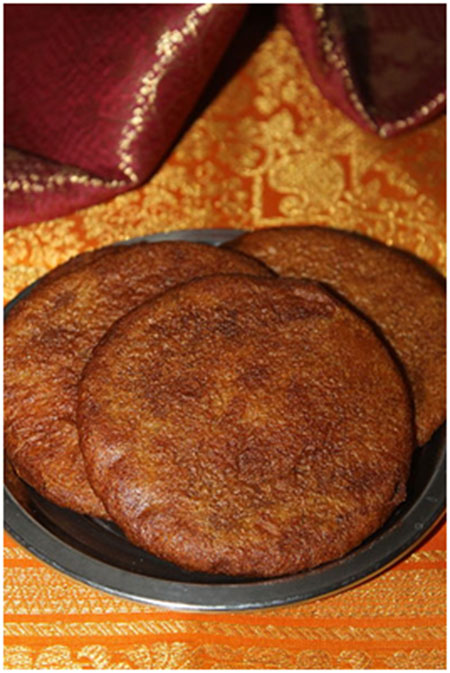
Local water bodies also provide ample seafood like crabs and different varieties of fish which arepopularly utilised in a lot of dishes. These are made usually during the monsoons.
It was also once customary to place beed is along with the betel nut plate, for departing guests, though not many follow that tradition today. Since betel is grown here, it is consumed on a daily basis by a large population too.
People living here have since time immemorial, been reliant on local produce that they grew on the land and source from the surrounding forests, and this is reflected in their cuisine. They take pride in everything they grow and hunt and that reflects in the way they cook their food and the way they enjoy their meals. They are basically self-sufficient in all that they eat, drink and grow.
You might travel the world and taste food from all corners of the world. But in Coorg you will taste flavours you didn’t even know existed! And will surely leave with a desire to return for the coffee and the food if nothing else!!